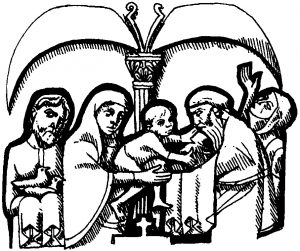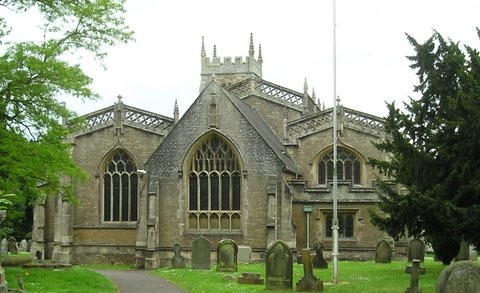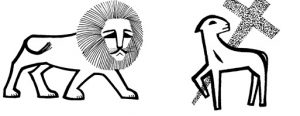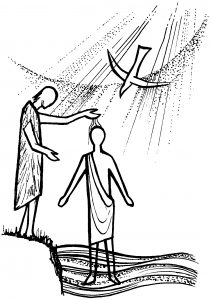Links to the video service: https://youtu.be/MFI7ulntNto
Links to Bishop Trevor Willmott’s reflection https://youtu.be/QWBJjFJLTP0
Revelation 5: 1-5a, Luke 2: 22-40
Candlemas is an occasion when we have often come together for worship. Frequently we are at Pen for this service and I love to see that church filled with candles. Have never understood why Candlemas falls on the celebration of the presentation of Christ until this year – I always assumed it was a case of the church making use of a date that was already in folk use, probably linked to the gradual returning of the light. There is a degree of truth in this, as the day falls halfway between the winter solstice and the spring equinox, and has long been a celebration of the returning daylight. We probably all know too that Candlemas has a weather association rather like St Swithin’s day that tells us roughly that the finer the weather on Candlemas, the more winter there is to come and conversely bad weather on that day indicates that the winter weather is largely over. Keep a look out on Tuesday!
Preaching is good for me though, as I have learned this year that Candlemas is the 40th day of, and therefore the end of the Christmas season. Apparently, it is also the correct day to take down any Christmas decorations that did not get taken down in time for twelfth night. In telling us this part of the story, Luke is reminding us of the piety of Joseph and Mary, and of their financial standing. As well as a sacrifice of thanks for the child and a safe delivery, it was customary to pay a small sum of money to the priest, to redeem or ‘buy back’ the child from God. It is a good reminder to all of us that our children are entrusted to us by God and are never really ours.
Light is a theme throughout Epiphany, which starts with the star which led the magi to Jesus, and when we celebrate the first sharing of the Saviour with gentiles as well as Jews and ends with Candlemas when traditionally the candles to be used in worship for the year would be brought into church to be blessed. This link with light however is taken from the wonderful words of praise and prophecy spoken by Simeon when he recognised the Christ child – ‘to be a light to lighten the gentiles, and to be the glory of thy people Israel’.
 Simeon also foretells that Christ’s life and ministry will not be easy, that he will show things that people would rather have kept secret, will meet with opposition and that his chosen path will cause grief to his family – and this last seems to be directed chiefly to Mary. This prophecy makes more sense to us who know what happened during Jesus life on earth and the manner of his death. The opposition to his life and ministry are also told in highly figurative language in our first reading, when John’s vision shows him the struggle between the powers of evil and good, and how the coming of Christ to the nation of Israel was opposed, but that this did not succeed.
Simeon also foretells that Christ’s life and ministry will not be easy, that he will show things that people would rather have kept secret, will meet with opposition and that his chosen path will cause grief to his family – and this last seems to be directed chiefly to Mary. This prophecy makes more sense to us who know what happened during Jesus life on earth and the manner of his death. The opposition to his life and ministry are also told in highly figurative language in our first reading, when John’s vision shows him the struggle between the powers of evil and good, and how the coming of Christ to the nation of Israel was opposed, but that this did not succeed.
We seem to know quite a lot about Simeon, but less about Anna. What we do know, if we disregard the information about her husband and her great age – in itself exceptional for the times, makes her an exceptional person. She is described as a prophet – one of very few women given that honour. She is sometimes described as the last of the Old Testament prophets and the first of the New Testament missionaries. Her long life has been spent in prayer and worship and she spends much time in the temple so in a way it is less surprising that she is there on that day than Simeon, although both were guided by the Holy Spirit. As soon as she saw the Christ child, she too was moved to praise as Mary had been at the annunciation, as the infant John the Baptist and his mother had been and as the shepherds were returning to the fields. Like the shepherds, Anna too told the news to the people she met. It would seem that people of prayer are also people of insight and at times of great joy.
I wonder if you, like me are finding this continued lockdown with so little happening a very difficult time to pray? In staying at home, we no longer meet up with people in the street, and exchange news, and the
news brought to us by the media seems to contain issues that are altogether too big for the scope of the prayers of someone like me. This is the weekend of the Big Garden bird watch – I wonder if many of you take part in this? If your experience is anything like mine, the hour you chose to watch will be the one when all the birds in Somerset chose to be somewhere else! I mention the bird watch, as I find comfort for my prayers which seem so inadequate in the words of Ann Lewin and her poem ‘Disclosure’ which can be found in her book ‘Watching for the Kingfisher’.
‘Bird watching has taught me that all is gift. I may go out hoping to see a particular bird – but it may not be in evidence. I can’t control the movement of the birds. And if I am too intent on seeing one particular bird, I may miss a lot of other things that are around. Prayer is like that:’
Disclosure
Prayer is like watching for the Kingfisher.
All you can do is
Be where he is likely to appear, and
Wait.
Often, nothing much happens;
There is space, silence and
Expectancy.
No visible sign, only the
Knowledge that he’s been there,
And may come again.
Seeing or not seeing cease to matter,
You have been prepared.
But sometimes, when you’ve almost
Stopped expecting it,
A flash of brightness
Gives encouragement.
Waiting for the Kingfisher, Copyright: Ann Lewin
Publisher: Canterbury Press Norwich. 30/11/2009


